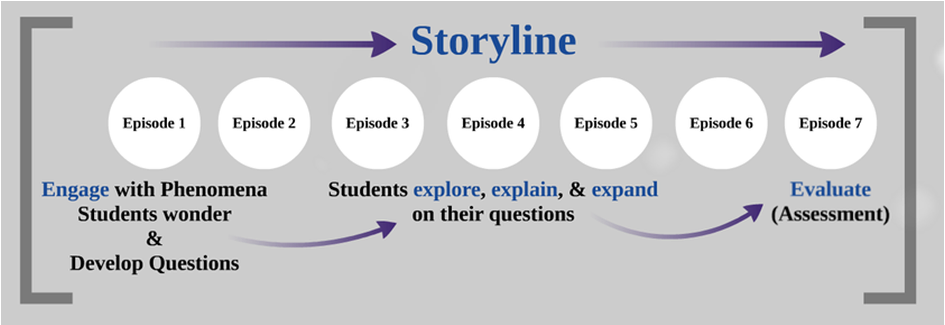The Case of the Missing Pumpkin
Students investigate the phenomenon of decomposing pumpkins as a part of the plant's life cycle.

Background
Lesson Activities
Recommended Companion Resources
Credits
Author
Pat Thompson and Lynn Wallin | National Center for Agricultural Literacy (NCAL)
Acknowledgements
Adapted with permission from a lesson plan originally developed by Oklahoma Agriculture in the Classroom.
- Storyline graphic from seedstorylines.org.
- Phenomenon chart adapted from work by Susan German.
German, S. (2017, December). Creating conceptual storylines. Science Scope, 41(4), 26-28.
German, S. (2018, January). The steps of a conceptual storyline. Science Scope, 41(5), 32-34. - Decomposing Pumpkin photo used with permission from Kevin Krejci.
- Activity 3 adapted from an activity originally developed by Rose Judd-Murray.
Standards
Indiana Content Area Standards
-
English Language Arts.Kindergarten.RL.1
Actively engage in group reading activities with purpose and understanding.
- Key Ideas and Textual Support.K.RL.2.1: With support, ask and answer questions about main topics and key details in a text heard or read. Further guidance for support will be provided in the Literacy Framework.
-
English Language Arts.Kindergarten.RN.1
Actively engage in group reading activities with purpose and understanding.
- Key Ideas and Textual Support.K.RN.2.1: With support, ask and answer questions about important elements of a text (e.g., events, topics, concepts). Further guidance for support will be provided in the Literacy Framework.
-
English Language Arts.Kindergarten.SL.1
Listen actively and communicate effectively with a variety of audiences and for different purposes.
- Comprehension.K.SL.3.1: Ask and answer questions about key details in a text read aloud or information presented orally or through other media.
- Comprehension.K.SL.3.2: Ask appropriate questions about what a speaker says.
- Discussion and Collaboration.K.SL.2.1: Participate in collaborative conversations about grade-appropriate topics and texts with peers and adults in small and larger groups.
- Discussion and Collaboration.K.SL.2.3: Listen to others, take turns speaking, and add ones own ideas to small group discussions or tasks.
- Presentation of Knowledge and Ideas.K.SL.4.3: Give, restate, and follow simple two-step directions.
-
English Language Arts.Grade 1.RN.1
With support, read and comprehend nonfiction that is grade-level appropriate.
- Key Ideas and Textual Support.1.RN.2.1: Ask and answer questions about key details to clarify and confirm understanding of a text.
- Structural Elements and Organization.1.RN.3.2: Identify how a nonfiction text can be structured to indicate order (e.g., sequential) or to explain a simple cause and effect relationship.
-
English Language Arts.Grade 1.RL.1
With support, read and comprehend literature that is grade-level appropriate.
- Key Ideas and Textual Support.1.RL.2.1: Ask and answer questions about main idea and key details in a text.
-
English Language Arts.Grade 1.RV.1
Use words, phrases, and strategies acquired through conversations, reading, and being read to, and responding to literature and nonfiction texts to build and apply vocabulary.
- Vocabulary in Literature and Nonfiction Texts.1.RV.3.2: Ask and answer questions to help determine or clarify the meaning of words and phrases in a nonfiction text.
-
English Language Arts.Grade 1.SL.1
Listen actively and adjust the use of spoken language (e.g., vocabulary) to communicate effectively with a variety of audiences and for different purposes.
- Comprehension.1.SL.3.2: Ask and answer questions about key details in a text read aloud or information presented orally or through other media.
- Discussion and Collaboration.1.SL.2.1: Participate in collaborative conversations about grade-appropriate topics and texts with peers and adults in small and larger groups.
- Discussion and Collaboration.1.SL.2.4: Ask questions to clarify information about topics and texts under discussion.
- Presentation of Knowledge and Ideas.1.SL.4.2: Add drawings or other visual displays, such as pictures and objects, when sharing information to clarify ideas, thoughts, and feelings.
- Presentation of Knowledge and Ideas.1.SL.4.3: Give and follow three- and four-step directions.
-
English Language Arts.Grade 2.RL.1
Read and comprehend a variety of literature within a range of complexity appropriate for grades 2-3. By the end of grade 2, students interact with texts proficiently and independently at the low end of the range and with scaffolding as needed at the high end.
- Key Ideas and Textual Support.2.RL.2.4: Make predictions about the content of text using prior knowledge of text features, explaining whether they were confirmed or not confirmed and why.
-
English Language Arts. Grade 2.RN.1
Read and comprehend a variety of nonfiction within a range of complexity appropriate for grades 2-3. By the end of grade 2, students interact with texts proficiently and independently at the low end of the range and with scaffolding as needed at the high end.
- Key Ideas and Textual Support.2.RN.2.1: Ask and answer questions about the main idea and supporting facts and details in a text to confirm understanding.
- Structural Elements and Organization.2.RN.3.2: Identify how a nonfiction text can be structured to compare and contrast, to describe a procedure, and to explain a cause and effect relationship.
-
English Language Arts.Grade 2.RV.1
Use words, phrases, and strategies acquired through conversations, reading and being read to, and responding to literature and nonfiction texts to build and apply vocabulary.
- Vocabulary in Literature and Nonfiction Texts.2.RV.3.2: Determine the meanings of words and phrases in a nonfiction text relevant to a second grade topic or subject area.
-
English Language Arts.Grade 2.SL.1
Listen actively and adjust the use of spoken language (e.g., conventions, vocabulary) to communicate effectively with a variety of audiences and for different purposes.
- Comprehension.2.SL.3.2: Ask and answer questions about what a speaker says to clarify comprehension, gather information, or deepen understanding of a topic or issue.
- Discussion and Collaboration.2.SL.2.1: Participate in collaborative conversations about grade-appropriate topics and texts with peers and adults in small and larger groups.
- Discussion and Collaboration.2.SL.2.4: Ask for clarification and further explanation as needed about the topics and texts under discussion.
- Presentation of Knowledge and Ideas.2.SL.4.3: Give and follow multi-step directions.

 place students in groups with one larger pumpkin per group. Tell the students that you are curious to know if a pumpkin can grow inside of a pumpkin. Conduct a class poll to determine how many students predict yes and how many predict no. Invite students from both sides to share why they answered yes or no.
place students in groups with one larger pumpkin per group. Tell the students that you are curious to know if a pumpkin can grow inside of a pumpkin. Conduct a class poll to determine how many students predict yes and how many predict no. Invite students from both sides to share why they answered yes or no.